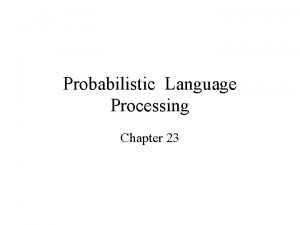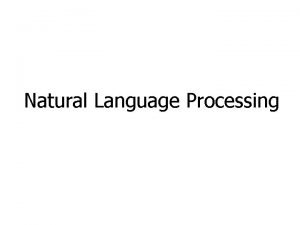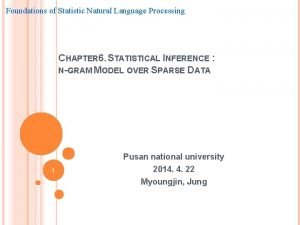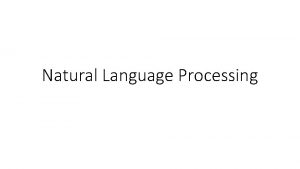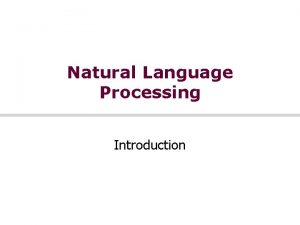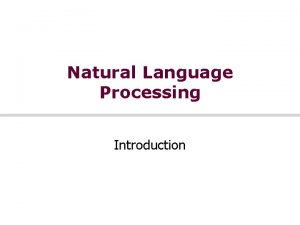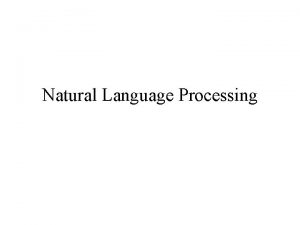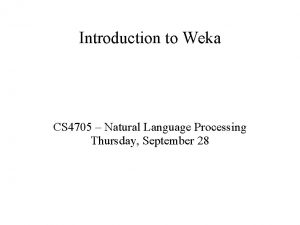A Short Introduction to Weka Natural Language Processing













- Slides: 13

A Short Introduction to Weka Natural Language Processing Thursday, November 5 th

What is weka? ● Java-based Machine Learning Tool ● Implements numerous classifiers ● 3 modes of operation – GUI – Command Line – Java API (not discussed here) ● Google: ‘weka java’

weka Homepage ● http: //www. cs. waikato. ac. nz/ml/weka/ ● To run: – java -Xmx 1024 M -jar ~cs 4705/bin/weka. jar &

. arff file format ● http: //www. cs. waikato. ac. nz/~ml/weka/arff. html % 1. Title: Iris Plants Database % @RELATION iris @ATTRIBUTE sepallength NUMERIC @ATTRIBUTE sepalwidth NUMERIC @ATTRIBUTE petallength NUMERIC @ATTRIBUTE petalwidth NUMERIC @ATTRIBUTE class {Iris-setosa, Iris-versicolor, Iris-virginica} @DATA 5. 1, 3. 5, 1. 4, 0. 2, Iris-setosa 4. 9, 3. 0, 1. 4, 0. 2, Iris-setosa 4. 7, 3. 2, 1. 3, 0. 2, Iris-setosa …

. arff file format @attribute attr. Name {numeric, string, <nominal>, date} § numeric: a number § nominal: a (finite) set of strings, e. g. {Iris-setosa, Iris-versicolor, Irisvirginica} § string: <arbitrary strings> § date: (default ISO-8601) yyyy-MMdd’T’HH: mm: ss

Example Arff Files ● ~cs 4705/bin/weka-3 -4 -11/data/ ● iris. arff ● soybean. arff ● weather. arff

To Classify with weka GUI 1. Run weka GUI 1. (in Unix: java –jar weka. jar) 2. Click 'Explorer' 3. 'Open file. . . ' 7. Click 'Start' 8. Wait. . . 9. Right-click on Result list entry 4. Select 'Classify' tab a. 'Save result buffer' 5. 'Choose' a classifier b. 'Save model' 6. Confirm options

Classify ● Some classifiers to start with. – Naive. Bayes – JRip – J 48 – SMO ● Find References by selecting a classifier ● Use Cross-Validation!

Analyzing Results ● Important tools for Homework 3 – Accuracy ● “Correctly classified instances” – F-measure – Confusion matrix – Save model – Visualization

Running weka from the Command Line ● ● http: //weka. wikispaces. com/Primer Running an N-fold cross validation experiment – ● java -cp ~cs 4705/bin/weka. jar weka. classifiers. bayes. Naive. Bayes -t trainingdata. arff -x N -i Using a predefined test set – java -cp ~cs 4705/bin/weka. jar weka. classifiers. bayes. Naive. Bayes -t trainingdata. arff -T testingdata. arff

● Saving the model – ● java -cp ~cs 4705/bin/weka. jar weka. classifiers. bayes. Naive. Bayes -t trainingdata. arff -d output. model Classifying a test set – java -cp ~cs 4705/bin/weka. jar weka. classifiers. bayes. Naive. Bayes -l input. model -T testingdata. arff ● Getting help – java -cp ~cs 4705/bin/weka. jar weka. classifiers. bayes. Naive. Bayes -?

Homework 3 Weka Workflow … T 1 Your Feature Extractor S 1 S 2 … TN Your Feature Extractor . arff Weka best model Test. arff SN results Preprocessing (you) Experimentation (you) Weka results Grading (us)

Tips for Homework Success ● ● Start early Read instructions carefully Start simply Your system should always work – 80/20 Rule – Add features incrementally – This way, you always have something you can turn in.
 Long and short
Long and short Weka introduction
Weka introduction Natural language processing vietnamese
Natural language processing vietnamese Probabilistic model natural language processing
Probabilistic model natural language processing Natural language processing
Natural language processing Markov chain natural language processing
Markov chain natural language processing Christopher manning stanford
Christopher manning stanford Pengertian natural language processing
Pengertian natural language processing Discourse analysis nlp
Discourse analysis nlp Nlp lecture notes
Nlp lecture notes Foundations of statistical natural language processing
Foundations of statistical natural language processing Natural language processing fields
Natural language processing fields Statistical nlp
Statistical nlp Natural language processing nlp - theory lecture
Natural language processing nlp - theory lecture



